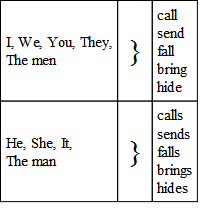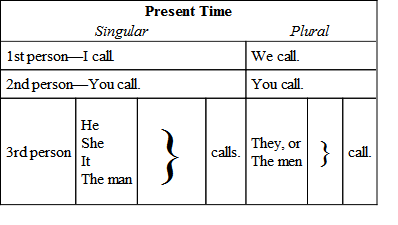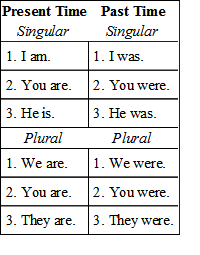INFLECTION—CHANGES IN FORM
104. You remember that nouns have certain changes in form to indicate changes in use. Verbs also have several changes in form to correspond with changes in their use or meaning. Notice the following sentences:
I think.
I thought.
I work.
I worked.
What is the difference in the meaning of I think and I thought? of I work and I worked? When we say, I think, or I work, we mean that the action is now, to-day, in the present; but when we say, I thought, or I worked, we mean that now is not the time of the action, but that the action was performed sometime in the past. So we have a change in the verb form to denote time. The simple form of the verb, like think or work, is used to denote present time. When we wish to express past time we do it by changing the form of the verb. Now note the following:

Now let us write this in another way.

105. You notice in this table we use the expressions first person, second person, and third person. I and we indicate the person or persons speaking and are called the first person. You indicates the person or persons spoken to and is called the second person. He, she, it, they, and the person or persons or things spoken of, are called the third person.
We use the word you when speaking to one or more than one now-a-days. It used to be that when speaking to a single person, people said thou, and in speaking to two or more they said you. But we today have dropped the old form thou, and use you for both singular and plural.
106. Now note, in the above table, that there is only one form change in the verb, and this is in the third person singular. We say I call, You call, We call, They, or The men call, but we say He, or the man calls, in speaking of one person or thing. So we change the form of the verb with any subject which denotes the third person and the singular number. This form is made by adding s to the simple form of the verb, therefore we may call it the s-form because it always ends in s.
Remember that this s-form is used to express present time with a third person, singular subject. BE CAREFUL NOT TO USE THIS FORM WITH ANY PLURAL SUBJECT. There is no other change in the verb form in expressing the present time in any verb, except in the verb be.
107. This little verb be is one of the most troublesome verbs in our language, and since it is used in forming verb phrases, it will be well to commit the following table to memory. Watch closely your use of this bothersome little word. Note that it has a change in form for the first person singular, as well as for the third person singular. All other verbs have just the one change, the s-form for the third person singular. The verb be has a form also to use with the first person singular, the pronoun I.

108. The present time form is the form which expresses present time. It is expressed by the simple form of the verb with the exception of the third person singular, which is expressed by the s-form.
Более 800 000 книг и аудиокниг! 📚
Получи 2 месяца Литрес Подписки в подарок и наслаждайся неограниченным чтением
ПОЛУЧИТЬ ПОДАРОКДанный текст является ознакомительным фрагментом.